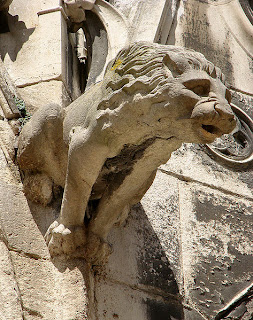 |
| Roman gargoyles |
The ancient Greeks and Romans and Egyptians were the first people to have gargoyles, and the reason they had them was so the gargoyles could spit rainwater out away from the sides of the buildings. Which was a good thing to do, because otherwise the rainwater would run down the outside walls and do bad things to the mortar that held the stones together.
 |
| Notre Dame Cathedral |
A gargoyle had a big groove cut into its back, and the rainwater went down this and out through the gargoyle's mouth. The longer the gargoyle was, the farther the water would shoot out away from the building. Sometimes there were gargoyles that were not waterspouts. They were just regular statues. The proper name for a gargoyle that is not a waterspout is a "grotesque."
 |
| Notre Dame Cathedral Photo @Paul Almasy/Corbis |
The word gargoyle sounds funny when you say it, and if you say it a whole bunch of times, really fast, your tongue gets totally tangled up. Gargoyle comes from the French word gargouille, which means "throat" or "gullet" in English. There are a bunch of other words in several languages that are similar in sound, and they mean things like "to gurgle," "to swallow," or "to gargle."
 |
| Cathedral in Quito, Ecuador |
The heyday of gargoyles was in medieval times, when lots of humongous cathedrals got built. The Cathedral of Notre Dame in Paris probably has the biggest collection of gargoyles and grotesques. The clergy made gargoyles into symbols of evil, and they were supposed to scare people into coming to church so that they wouldn't go to hell and get eaten by horrible monsters. People could feel safe inside the church while they prayed, because the evil creatures could not come in. But some medieval clergy didn't like the gargoyles and thought they seemed like some sort of idolatry.
 |
| Cathédrale de Meaux, South Transept Photo by Vassil |
Most people didn't know how to read back in those days, so that's why the priests gave meanings to the gargoyles and grotesques, and then they used them to teach people. For example, one of the animals used most often was the lion. It symbolized pride, which was one of the 7 deadly sins.
 |
| Notre Dame Cathedral |
Dogs were also used as gargoyles. Dogs were faithful and loyal and intelligent, but sometimes they stole food from people's kitchens. This showed how the Devil could tempt a good creature to do bad things. Wolves represented the leadership of the priests, but also symbolized greed. Chimeras were animals that were made up of a mix of body parts, like for example, a mermaid is a chimera and so is a centaur. Chimeras were a warning to people who let themselves be tempted by the devil.
 |
| Rosslyn Chapel, Roslin, Scotland Photo by Ludi Ling |
By the early 18th century, lots of buildings started to have gutters that carried water to drainpipes. So this meant that gargoyles weren't being used anymore. Which was good because sometimes they fell down and caused a lot of damage. In 1724, the Parliament of Great Britain passed a law that required all new buildings to be built with drainpipes.
 |
| Chrysler Building, NY City Photos: Fotothing, XRoads, Allnbdt |
There are still a few churches and other places being built nowadays that have gargoyles. Well, they are not real gargoyles that act as waterspouts. These are more like grotesques or decorative features. For instance, the Chrysler Building in New York City was finished in 1930 in the Art Deco style, and it has a bunch of gargoyle-type things on it.
 |
| National Cathedral, Washington D.C. Photos: Stonecarver, io9 |
Also, the National Cathedral in Washington, D.C. has grotesques on it. Some of these are very modern, like for instance Darth Vader from Star Wars.
I guess these gargoyles are kind of cute, but I am glad that our house doesn't have any on it. This is because I think that it would look weird to have gargoyles on a colonial-style house. And also, I would always be afraid that one would fall off and hit me in the head. Some people have gargoyles sitting around in their yards. If you want one, this would probably be the best thing to do with it. But I hope Mom doesn't decide to get one. It's bad enough that we have to put up with that garden gnome she bought a couple of years ago!
















.jpg)































